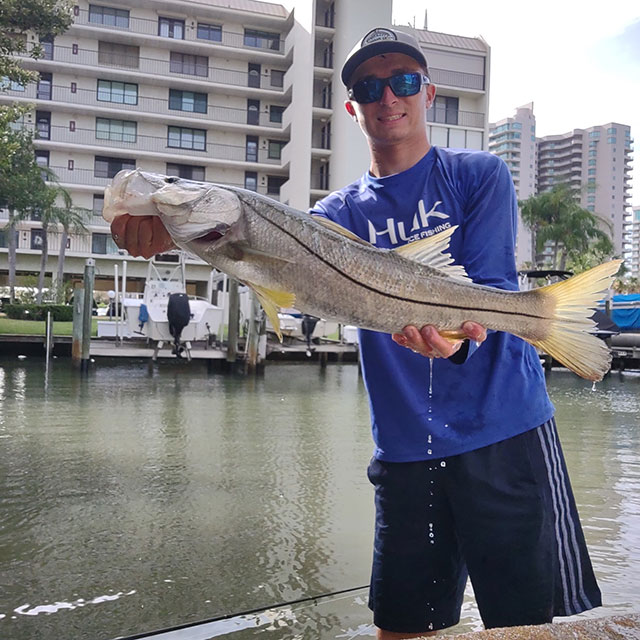Fishing docks is one of my favorite techniques, especially when I’m saltwater fishing.
Many different types of fish use boat docks as cover and protection from prey, as well as to stay cool in the heat of the day. There are usually a group of fish that use docks as cover year-round, so there’s always a few fish to be caught underneath these structures.
Some of the biggest fish I’ve ever caught have come from under docks. This article will discuss how to target and catch some awesome saltwater species when fishing under and around boat docks.
Types of Docks
The first thing to consider is what type of docks you want to fish.
Docks can be made of several kinds of material. There are two main types of docks:
- Fixed docks are immobile and built into the ground under water. They have poles or pilings that keep them held into place.
- Floating docks are buoyant and float on the surface. Both types of docks provide shade and shelter for fish.
Fish won’t always use the same type of dock. Depending on the situation, fish may only be on one type of dock. That’s where it becomes the angler’s job to narrow down what kind of docks most of the fish are holding under.
I typically like to fish fixed docks during the summer because they provide more shade than floating docks. And I like to fish floating docks in the winter because the plastic holds heat and often attracts fish that are looking for a place to warm up.
Types of Saltwater Fish Caught Around Docks
There are a variety of saltwater species that use docks for cover. I generally target:
However, many other fish, such as seatrout, flounder, snapper, and sheepshead, among others, live under docks as well. Many of these fish will all live under the same docks together, so anglers have a chance to catch multiple species while fishing a single dock.
Best Time to Fish Docks
Although many anglers will recommend early morning or dusk, I’ve actually found that the best time to fish boat docks is during the middle of the day.
During the summer, fish are using docks to cool off, and in the winter, they use them to warm up. So, no matter the time of year, it seems that when the sun is the highest the dock bite is better.
What to Look For Dock Fishing

Anglers should target docks that are in high percentage areas. For example, look for docks located
- On points
- Along channels
- Around flats and oyster bars
- Near deep water
Also, the first and last dock in a row of docks are often the best because they will be the first structure a fish stops at when moving into the area.
Another thing anglers should keep on eye out for is old, broken-down boat docks. Older docks tend to hold more fish and have more life around them. A lot of docks have rock piles or debris under and around them. These docks are often loaded with fish that are hiding in and around the rocks and rubble and are especially good for catching grouper and snapper.
Anglers should note that fish may not use the same docks or same parts of a dock all times of the year. During the summertime, fish like to hang out under deeper docks where the water is cooler. In the winter, they like the shallower docks because that water will warm faster. Its important for anglers to keep this in mind when docks fishing during different parts of the year.
Best Baits/Lures for Dock Fishing
Anglers have the choice to use live bait, dead bait or artificial lures when dock fishing. Some of the best lives or dead baits include:
- Shrimp
- Crabs
- Pilchards
- Threadfins
- Finger mullet
- Sardines
- Pinfish
- Grunts
When fishing live bait around docks, I either freeline my baits without a weight or use a small split shot sinker to keep the bait in one spot under the dock. I use a 1/0-4/0 hook depending on the size of my bait and the type of fish I’m targeting.
I most often use artificial lures when I’m fishing docks. Some of my favorite lures for this technique include,
- Imitator Shrimp (Berkley Gulp Shrimp)
- Paddletail swimbaits on ¼-¾ oz. jighead (DOA C.A.L. Swimbait)
- Soft plastic jerkbaits (DOA Jerk Shad)
Each of these lures are lightweight enough to skip far underneath docks, allowing me to reach areas other anglers haven’t. Being able to skip a bait deep into a dock is often crucial for success.
When it comes to colors for artificial lures, I prefer brown, green, pearl white, chartreuse and clear. I’ve found that white often works better for snook, while brownish green color patterns work better for redfish. I vary the size of my jighead based on the water depth and how spooky the fish are. The lighter the jighead the less likely it is to spook a wary fish when it enters the water.
Best Tackle for Dock Fishing
When dock fishing, I generally like to use a setup that is light enough to skip baits a long ways, but heavy enough to get big fish away from the structure quickly. I prefer a 7’ medium heavy inshore spinning rod, paired to a 4000 sized reel. I’ll spool the reel with 20 pound braided line and tie a 25-50 pound leader to the braid. I’ll vary my leader size depending on the type and size of the fish I’m targeting. This setup will handle most fish that can be caught around docks.
However, I will go with a heavier rod and reel if I’m targeting grouper or big snook. These fish are often too powerful for a medium heavy rod. Therefore, I’ll go with a 7’ heavy action spinning rod and pair it to a 5000 sized reel with pound braided line and a 40-50 pound leader. Anglers will still get broke off from time to time, but a rod and reel of this size can more easily handle those strong dock giants.
Back to You
It can be a challenge to get big fish out from under dock without getting cut off by oysters or dock pilings. However, that challenge is what makes dock fishing is a super fun way to fish. There’s nothing quite like trying to battle a giant fish out from under a dock.
Anglers who become good at dock fishing will up their game tremendously and will start catching more fish. My hope is that this article helps you become a better dock fisherman and helps to increase your overall fishing skills.
Now get out there and keep your hooks wet!
